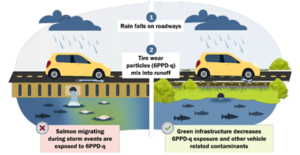The state of Washington releases report for mitigating tire additive 6PPD in road runoff
Olympia, WA – In December 2020, a Puget Sound-based stormwater science team identified the contaminant responsible for pre-spawn coho mortality observed in urban areas for many decades. The contaminant is 6PPD: N-(1,3-dimethylbutyl)-N′-phenyl-p-phenylenediamine, a tire additive that enhances tire longevity, with
6PPD-q: 6PPD-quinone, the transformation product.
With this harmful contaminant identified, steps were needed to address the threat to aquatic life from roadway runoff. The Washington State Department of Ecology (Ecology) was directed by the state Legislature to seek interim strategies to address the issue until longer-term solutions could be identified. The interim strategies describe best management practices (BMPs). Priority areas were defined by their vulnerability to the co-occurrence of the contaminant and salmon.
In collaboration with Washington State Department of Transportation (WSDOT), University of Washington Tacoma (UW Tacoma) and Washington State University – Puyallup Extension (WSUPuyallup), two expert workgroups convened to form technical advisory committees to help review scientific and technical information in order to inform next steps for assessment strategies and mitigation actions.
For the assessment strategies workgroup, a letter was sent to Washington Tribes with interests residing in Washington watersheds and streams to solicit information and request participation to develop a prioritization process of next steps for state action and implementation. Federal and state agencies, local governments, universities, and non-governmental organizations also provided the most up-to-date scientific information regarding 6PPD-quinone and discussed data gaps. Collectively, this group provided technical recommendations based on vulnerabilities of salmon to the contaminant at the sub-watershed level. This group also created a process that could be used for future efforts to inform implementation prioritizations for reducing tire contaminants exposure to vulnerable aquatic areas.
Ecology recognizes that salmon bearing watersheds and streams have Treaty Rights and reserved rights attached to them by federally recognized tribes. This sets a high priority for Ecology and other state agencies to quickly determine and implement remedial efforts on 6PPD-q in consultation with Indian Tribes.
The full report can be found here: https://apps.ecology.wa.gov/publications/documents/2203020.pdf

